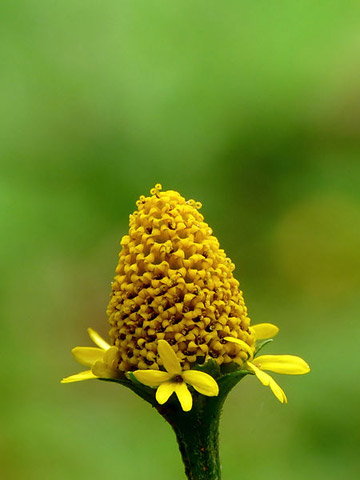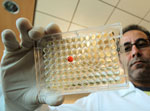The world may soon benefit from a plant long-used by indigenous people in the Peruvian Amazon for toothaches, eliminating the need for local injections in some cases. Researchers have created a medicinal gel from a plant known commonly as spilanthes extract (Acmella Oleracea), which could become a fully natural alternative to current anesthetics and may even have a wide-range of applications beyond dental care.
“We could be looking at the end of some injections in the dentist’s surgery. We’ve had really clear result from the tests so far, particularly for peridodontological procedures such as root scaling and planing, and there are many other potential applications. The native forest people described to me exactly how the medicine could and should work and they were absolutely right,” Cambridge University anthropologist, Françoise Barbira Freedman, said in a press release.
 Acmella oleracea has led to a possible new treatment for dental pain. Photo by: Jkadavoor. |
Freedman was the first westerner to live with the Keshwa Lamas indigenous tribe in Peru; they introduced her to the power of spilanthes extract, which is grown ornamentally around the world but native to the Amazon. In 1975 one of the tribe alleviated pain in Freedman’s wisdom teeth by having her bite into the plant.
“During the time I have spent with the Keshwa Lamas I’ve learnt all about the different plants and leaves they use for everyday illnesses and ailments. I first went to Peru as a young researcher hoping to learn more about what was a secretive community who were experts in shamanism. Along the way I’ve learnt a great deal about natural medicines and remedies; everything from toothache to childbirth,” Freedman says.
Freedman has now founded pharmaceutical company Ampika Ltd., which is linked to Cambridge University’s commercial arm. A portion of proceeds from the company will also be shared among the Keshwa Lamas people, who Freedman still visits.
Beyond dental operations, the gel may also alleviate infant pain during teething.
“There are a range of mucous tissue applications it could benefit, and may even help bowel complaints such as IBS (irritable bowel syndrome),” says Freedman.
The medicinal gel is currently in trials, but Freedman says she expects it to be on the market by 2014 or 2015.
Although the world’s tropical rainforests are under assault by logging, agriculture, monocultures, cattle, and fossil fuel industries, scientists believe the forests contain an untapped medicine cabinet that could provides cures for many of the world’s ailments. Currently less than 5 percent of the world’s tropical forest plants and less than 0.1 percent of its animals have been tested for medicinal properties.
Related articles
Losing nature’s medicine cabinet

(10/04/2010) In all the discussions of saving the world’s biodiversity from extinction, one point is often and surprisingly forgotten: the importance of the world’s species in providing humankind with a multitude of life-saving medicines so far, as well as the certainty that more vital medications are out there if only we save the unheralded animals and plants that contain cures unknown. Already, species have provided humankind everything from quinine to aspirin, from morphine to numerous cancer and HIV-fighting drugs. “As the ethnobotanist Dr. Mark Plotkin commented, the history of medicine can be written in terms of its reliance on and utilization of natural products,” physician Christopher Herndon told mongabay.com. Herndon is co-author of a recent paper in the journal Biotropica, which calls for policy-makers and the public to recognize how biodiversity underpins not only ecosystems, but medicine.
Zoopharmacognosy: how self-healing animals could save humans

(11/27/2011) As humans we take many things for granted. When we come down with a sore throat, a fever, or the dreaded stomach flu, we drag our aching bodies into our cars and visit the doctor. Animals have no such luxury. Instead they have mastered evolution and have acquired an innate knowledge of the plants, soils, minerals, algae, and other remedies that nature offers to heal their aches and pains.
Chemotherapy tree facing extinction
(11/10/2011) A yew tree in the Himalayas that produces the chemotherapy drug, Taxol, is in danger of extinction. An update to the IUCN Red List, has moved the tree, named Taxus contorta, from Vulnerable to Endangered. Overharvesting for medicine and fuelwood have placed the species in serious danger.
Australian rainforest plant yields possible cancer killer
(06/14/2010) A drug derived from a plant native to the Australian rainforest may prove to be a new weapon against cancer, according to the AFP. QBiotics Ltd has released a statement announcing that a drug made from the seeds of a rainforest shrub has successfully treated tumors in over 150 animals, and the company is now preparing to test the drug on humans.
(06/14/2010) If someone saves your life, you want to express your gratitude however you can — a gesture, a “thank you,”, or somehow returning the favor. Yet when you owe your life to a plant found thousands of miles away, the task becomes much harder. As a nurse, I’ve known for years that many life-saving medicines come from plants and animals found around the world. But I never thought that one day I would have to rely on the bark of a rare Asian tree to survive.